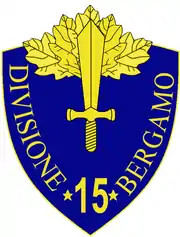15th Infantry Division Bergamo
The 15th Infantry Division Bergamo was an infantry division of the Italian Army during World War II. It was formed 24 May 1939 in Opatija.[1]
| 15th Infantry Division Bergamo | |
|---|---|
 15th Infantry Division Bergamo Insignia | |
| Active | 1939–1943 |
| Country | Kingdom of Italy |
| Branch | Royal Italian Army |
| Type | Infantry |
| Size | Division |
| Nickname(s) | Bergamo |
| Engagements | World War II |
| Commanders | |
| Notable commanders | General Pietro Belletti |
| Insignia | |
| Identification symbol |  |
| Identification symbol | Bergamo Division collar insignia |
History
Initial deployment
From 10 June 1940, the Bergamo division was assigned to border guard duty in Rijeka-Brešca(near Matulji)-Klana sector. The Bergamo division was part of the Italian V Corps that took part in the Invasion of Yugoslavia.[2] 6 April 1941, Bergamo division has received orders to advance. By 11 April 1941, it broken through Yugoslavian defences at Veli Vrh summit near Drenova, Rijeka, and captured the Kastav the same day. By 12 April 1941 it has reached the Bakar, continuing to advance to the south. 16 April 1941, the Bergamo division has captured Žuta Lokva village. After the invasion it was stationed in Dalmatia, in particular in city of Makarska, towns of Livno, Sinj, Ljubuški, Imotski and on the Brač island.
Fighting the partisans
From 22 July 1941 to 25 July 1941, the Bergamo division has fought the Yugoslavian partisans near the town of Drvar. Another large surge of fighting with partisans trying to infiltrate Croatia has happened from 9 October 1941 to 9 November 1941, across Croatian-Yugoslavian border. Afterward, the main duties of Bergamo has become the coastal defence, protection of roads and peacekeeping between the Yugoslavian and Croatian communities. In June 1942, it has suppressed a major revolt in Lika region. The Bergamo Division took part in Operation Alba which was an anti Partisan operations in Croatia carried out on 12 August to 2 September 1942, to destroy partisan groups in the Biokovo area 40 to 50 kilometres east of Split. Italian forces burned down 10 villages and killed and arrested several hundred people.[3][4] In 1943, increasingly bloody skirmishes with partisans were fought until 8 September 1943.
The defeat
After the Italian surrender in September 1943, it resisted the German forces but was defeated and some of the division's officers were executed by order of the German XV Mountain Corps, others evaded capture and joined the Yugoslav Partisans.[5]
XV Mountain Corps war diary
Daily Report from Commander in Chief Southeast (Army Group F)
- 9/27/1943, Banja Luka – 0700 hours SS Division and 92d Motorized Regiment approached Split.
- 0800 hours reached northern edge of Split.
- 0900 hours city and port of Split occupied against local resistance. 202 Italian officers and 9000 men captured. Italian officers are to be shot to death according to Fuehrer orders. Commanding General has caused investigation to ascertain guilty officers.
- 9/28/1943, :At Split 300 Italian officers and 9000 men of the "Bergamo" Division were taken prisoners. Treatment in compliance with Fuehrer order has been initiated.
- 9/30/1943, Banja Luka – Three generals in Split shot to death by virtue of summary court martial.
- 10/1/1943, Banja Luka – 45 additional guilty officers (Italian) shot to death by virtue of summary court martial in Split.[7]
Commander
General Pietro Belletti
Order of battle
- 25. Bergamo Infantry Regiment
- 26. Bergamo Infantry Regiment
- 4. Carnaro Artillery Regiment
- 89. CCNN Legion (Blackshirts)
- 15. Mortar Battalion
- 15. Anti-Tank
- 15. Signal Company
- 36. Pioneer Company
- 19. Medical Section
- 131. Field Hospital
- 132. Field Hospital
- 116. Supply Section
- 22. Motor Transport Section[5][nb 1]
Notes
- Footnotes
- An Italian Infantry Division normally consisted of two Infantry Regiments (three Battalions each), an Artillery Regiment, a Mortar Battalion (two companies), an Anti Tank Company, a Blackshirt Legion of two Battalions was sometimes attached. Each Division had only about 7,000 men, The Infantry and Artillery Regiments contained 1,650 men, the Blackshirt Legion 1,200, each company 150 men.[8]
- Citations
- regioesercito.it/reparti/fanteria/rediv15.htm
- Solitario, Lupo. "Invasion of Yugoslavia (6 April 1941)". Commando Supremo. Archived from the original on 21 May 2009. Retrieved 16 April 2009.
- Hronologija oslobodilačke borbe naroda jugoslavije 1941–1945 (Belgrade, 1964), p.323
- Oslobodilački rat naroda Juooslavije 1941–1945, 2 Vols (Belgrade: 1965), p.298
- Wendal, Marcus. "Italian Army". Axis History. Retrieved 16 April 2009.
- (Name) FORESIO – (C.R. File Number) 190961 – (Rank, Occupation, Unit, Place and Date of Crime) – Commandant, Italian Army, Div. Bergamo, Sibenik (Yugo.) 9.6.43 – (Reason wanted) Murder – (Wanted by) Yugo.; GRIMALDI Paolo – 190980 – Lt. General, Ital.Army Div."Bergamo", Sibenik (Yugo.) 41–43 – Murder – Yugo.; PIAZZONI – 149085 – Lt. General, Italian Army, "Bergamo" Div., Bickovo (Yugo.) 42 – Torture – Yugo.. In: The Central Registry of War Criminals and Security Suspects, Consolidated Wanted Lists, Part 2 – Non-Germans only (March 1947), Uckfield 2005 (Naval & University Press, facsimile edition of the original document at the National Archives in Kew/London), pp. 63, 65, 69.
- Document NOKW-1354, Prosecution Exhibit 447: Extracts of Daily Reports from Commander in Chief Southeast, 9/19-28/1943, to Operations Section, OKH: Extract of 9/28/1943", in Trials of War Criminals Before the Nuernberg Military Tribunals Under Control Council Law No. 10. Vol. 11: United States of America v. Wilhelm List, et al. (Case 7: 'Hostage Case'). US Government Printing Office, District of Columbia: 1950. pp. 1085–1086:
- Paoletti, p 170
- Paoletti, Ciro (2008). A Military History of Italy. Greenwood Publishing Group. ISBN 0-275-98505-9.